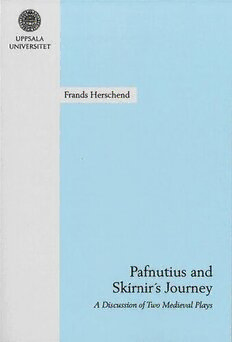
Pafnutius and Skírnir's Journey: A Discussion of Two Medieval Plays PDF
Preview Pafnutius and Skírnir's Journey: A Discussion of Two Medieval Plays
OCCASIONAL PAPERS IN ARCHAEOLOGY 65 1 2 Frands Herschend Pafnutius and Skírnir’s Journey A Discussion of Two Medieval Plays 3 Frands Herschend, Department of Archaeology and Ancient History. Box 626, Uppsala University, SE-751 26 Uppsala. Sweden. Distribution: [email protected] © Frands Herschend 2018 Language revision: Elisabet Green ISSN 1100-6358 ISBN 978-91-506-2709-1 Printed in Sweden by Kph Trycksaksbolaget AB, Uppsala 2018. 4 Contents Foreword ............................................................................................. 7 Was there a 10th Century Northwest European Drama? ..................... 9 Part One Hrotsvit ................................................................................. 15 ‘Nor See Anyone Performing Plays’ ................................................... 17 The Reception of Hrotsvit’s Plays ................................................. 17 The Royal Canoness Abbey .......................................................... 21 The Role of Educated Upper-Class Women ................................. 26 Playwright in Residence ................................................................ 30 Hrotsvit’s Failed Project ................................................................ 33 Hrotsvit’s Approach .......................................................................... 36 The Drama Section....................................................................... 36 Conclusion ................................................................................... 51 Hrotsvit’s Pafnutius ........................................................................... 52 Introduction ................................................................................. 52 Legend and Liturgy as Drama ....................................................... 56 A Note on the Translation ............................................................ 63 Two Scenes from Pafnutius ................................................................ 68 Scene II: The Forum in Alexandria ............................................... 68 Scene III: In Front of Thaïs’ House ............................................... 70 Gossip and Science ....................................................................... 74 Part Two Skírnir .................................................................................... 79 Structuring Dialogue ......................................................................... 81 Introduction ................................................................................. 81 Speaker Notations ......................................................................... 84 Things Heard and Seen ................................................................ 93 The Stage and its Scenery .................................................................. 97 The Theatrical Setting .................................................................. 97 Performance and Space ................................................................. 98 The Hall as Arena ....................................................................... 103 Conclusion ................................................................................. 122 Translating Fǫr Skírnis as a Play ...................................................... 125 A Note on the Translation. ......................................................... 126 Fǫr Skírnis as Historical Drama ....................................................... 132 Pantomimes ................................................................................ 132 Spare the Rod and Spoil the Child? ............................................ 135 The Distorted Myth ................................................................... 137 The Supportive Roles.................................................................. 140 The Dramatic Climax ................................................................. 142 The Main Characters .................................................................. 144 The Story .................................................................................... 148 Conclusion ................................................................................. 166 Part Three Comparison ....................................................................... 171 Fǫr Skírnis and Pafnutius ................................................................. 173 Paired Differences and Similarities .............................................. 173 Dramaturgical Similarities .......................................................... 177 Conclusion: Authors and their Plays ........................................... 192 References ............................................................................................ 195 Foreword THERE IS SELDOM any need to write a scholarly book about a subject related to past cultures. An article or a contribution to an anthology may be important enough to fill a limited need, but a longer work has boring parts and they tend to travesty the concept. If a need is felt, it is most likely the author who feels it – as in this case. However, to begin with no commitment whatsoever was involved in the case. Working on a synthesis of Late Iron Age South Scandinavia, which I still do, it became obvious that some of the poems in the Poetic Edda represented a Late Viking Age critique of the elite that emerged in the early 6th century CE. This was an important fact, since we do not expect Scandinavian prehistory to express historically based criticism of its own past as a way of commenting upon its own present. We reserve that kind of historicism to cultures characterised by literacy and formal education, i.e. something rather un-Viking. Some of the Eddic poems belonged among the dialogical plays con- vincingly singled out by Terry Gunnell (1995), whose perspective was ethno- logical. Gunnell’s research was ground-breaking, but in addition to being plays with links to folklore and mythology, I thought that some of these plays stood out as burlesque historical comedies linked to a group of mimetic performances meant to entertain Saxon, Norman, Anglo-Saxon and Scandinavian elites with mimetic theatre productions. Moreover, compared to the first contemporary religious plays these occasional ones were sophisticated in a way that would stand out as anachro- nistic to many researchers, not least those who comprise an evolutionary view on the history of theatre. There is no reason to believe that this book will convince a majority of its readers. Many will probably never finish it, but in the present case, and despite its boring parts, this is of little importance, inasmuch as the very situation including the book’s likely future reception has created a need to argue a case: The well-known mythological poem Skírnismál is a burlesque wedding entertainment shaped as a mimetic play – a historical com- edy in a historical setting – mocking the past. Uppsala June 2018 7
